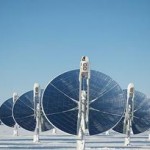
This GE wind turbine blade sat in front of the Dallas Convention Center, and was autographed by hundreds of attendees.
Among the highlights for some was a speech by former President George W. Bush, who shared Texas’s recipe for wind energy success and a vision of a secure American energy future with wind energy “on the leading edge,” powering not only our homes and businesses but also our cars. An all-time record for wind power production in Texas also occurred at the opening of the conference on May 23, when wind power hit an all-time production high, with 6,721 megawatts (MW) produced at 5:16PM – meeting 14% of peak electricity demand in Texas on that hot afternoon.
Statistics revealed at the conference that Texas added more wind power in 2009 alone than California has added over the past 30 years! This, despite the fact that California featured more than 90% of the world’s capacity in 1986. The downside to the Texas story is that 17% of the state’s wind power had to be curtailed in 2009 due to lack of adequate transmission capacity.
It is clear that wind power has gone mainstream. As Cathy Zoi, assistant secretary of energy efficiency and renewable energy at the federal Department of Energy put it: “This event feels sort of like Woodstock — but for capitalists!”
While fresh polls show that 89% of the general public wants more wind power, the nation — and California — will have to tap a variety of renewables to meet our climate change carbon emission reduction goals.
Among the less known opportunities are technologies such as Concentrated Solar Power (CSP) and geothermal energy.

An emerging CSP technology winning support from the federal government is Infinia’s Solar Power Dish
While the bright spot in California is solar photovoltics (PV), some suggest the state’s approach of only promoting distributed applications at homes and businesses or large-scale utility plants misses the boat. Germany’s approach — based on a policy called a “feed-in tariff” that allows solar generators to plug directly into the wholesale power grid — has installed more than 17 times the amount of solar PV as has California, despite the fact that California’s solar resource is 70% more efficient.
While the California Solar Initiative is a long-term program, incentives are capped at 1 MW. Under the best scenario, this program will only provide 2% of California’s total electricity demand by 2017.


